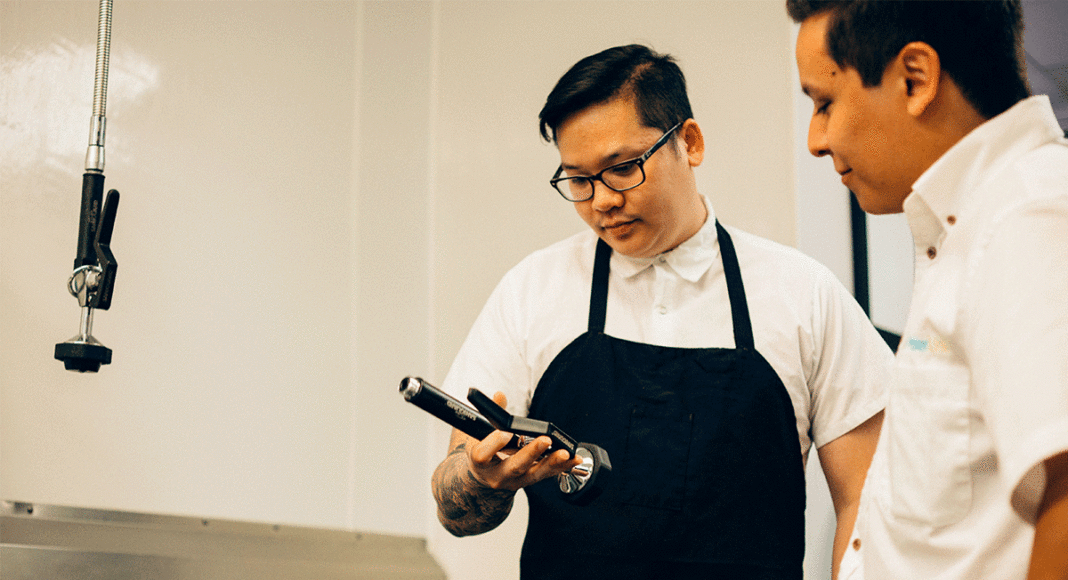The first time Cynthia Padula knocked on someone’s door to try to convince them to install low-flow showerheads and faucet aerators, she didn’t know what to expect—or, really, what she was doing.
“It took a while getting used to knowing what to say and getting inside houses,” says Padula, an environmental consultant who works as a field manager for WaterLink, an Ecology Action program that brings water-saving help to lower-income communities. “But people were very, very welcoming. They offered food and drinks all the time.”
That was a surprise, and not just to Padula.
“It’s funny, because we didn’t know if people would let us into their house, period,” says Kirsten Liske, vice president of community programs for Ecology Action. “And then secondly, ‘can we come into your bathroom?’ Think about the state of your bathroom right now, or mine. In these neighborhoods, people are really welcoming, and they offer us empanadas, and we get to meet their grandkids. It’s a really cool experience.”
Under the program’s policy, team members would not accept food, Padula says, but sometimes they would leave with a few bottles of water on scorching-hot South Bay Area afternoons, when their hosts insisted.
Ecology Action launched WaterLink in East San Jose last summer, and this year the Santa Cruz-based nonprofit announced it had won a $5 million grant to grow the effort—it will expand over the next few months into Watsonville, Salinas, Santa Clara, East Palo Alto, Hayward, and Daly City. The money comes from revenue out of the state’s cap-and-trade program that funds sustainability programs.
With WaterLink, Liske says that Ecology Action targeted communities that rely on groundwater—a resource hit hard by five years of drought—as well as areas that California recognizes as “disadvantaged.” State law requires that 25 percent of the cap-and-trade revenue go toward communities that historically sit lower on the totem pole, where residents face more obstacles to success. Using an algorithm called the CalEnviroScreenTool, the state identifies the 25 percent most challenged communities—taking into account income, language, education, pollution and water quality—requiring that a quarter of the money go there.
“It’s all from really simple measures, but a lot of these folks don’t get the upgrades from their landlords, or they can’t afford them,” Liske says. “And honestly, we all probably could do better in our own homes.”
In addition to aerators and showerheads, WaterLink will give away 100 dishwashers or washing machines, and Liske says teams will award them to “neighborhood leaders” who refer 10 other people that sign up. If a home has a substantial leak, WaterLink can pay up to $300 toward fixing it.
Ecology Action estimates the program will save customers $1.5 million each year on water costs, while serving 15,800 homes.
WaterLink also works with businesses, offering them brand new pre-rinse spray valves, or rebates toward new dishwasher systems. Between businesses and homes, Ecology Action projects the whole program will save 3.6 billion gallons of water annually.
Liske says the people they met care deeply about conservation, but simply don’t have the resources, time or information to do much about it. In Watsonville, 40 percent of the service area’s demand comes from low-income housing, according to a letter in support of WaterLink from the city’s Public Works Director Steve Palmisano to the Department of Water Resources.
In the afternoons, field teams gather in public parks for meetings and use a mapping software which helps them keep track of which homes they already visited. When team members enter houses, they strike up conversations about saving water with curious residents, who often follow them through various rooms to see what work they’re doing. When people aren’t home, WaterLink crews leave behind flyers with contact information or a time they’ll be returning.
Last year, an eclectic blend of team members covered six languages—English, Spanish, Vietnamese, Portuguese, Tagalog, Mandarin, “and we ended up using them all,” Liske says.
Ecology Action assumed this would be a grueling operation. “We really trained the team to do a sales pitch,” field manager Mariana Ivancko says. “They didn’t need to work so hard. The communities were very receptive to our program.”
Teams learned some interesting lessons along the way. Certain neighborhoods that ended up in WaterLink’s walks appeared to be more middle-class than others, and those were the ones where people appeared least keen—and less likely to open the door for strangers.
Some mobile home parks made the outreach job especially easy—perhaps because they have tighter-knit communities, and are used to talking to neighbors, Ivancko says.
Padula expected to be back at her environmental consulting gig this summer, but found herself getting drawn back in for a few more months of field work. Originally from Argentina, Padula first applied for the position last year to get a different kind of work experience.
“Something that I really discovered is that I really enjoy working with people,” she says. “I get all this energy—rejuvenated.”













